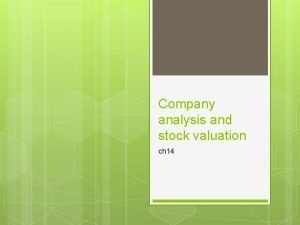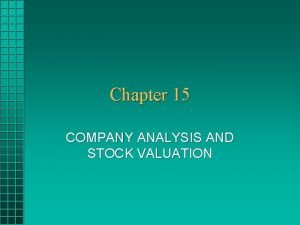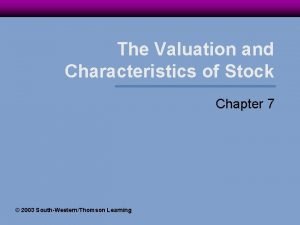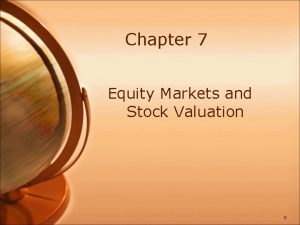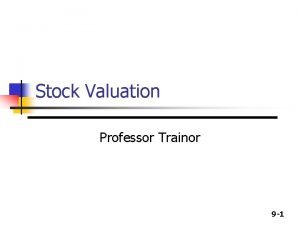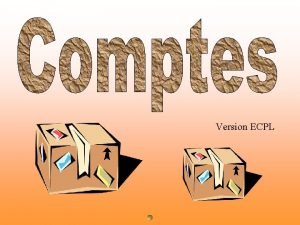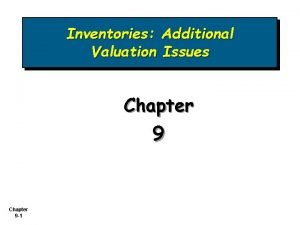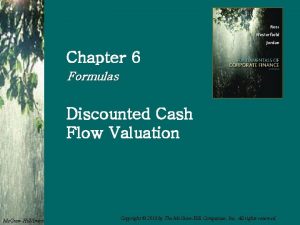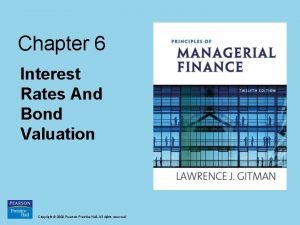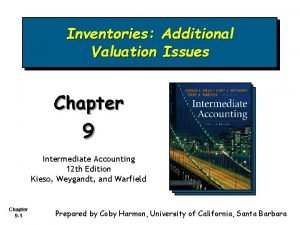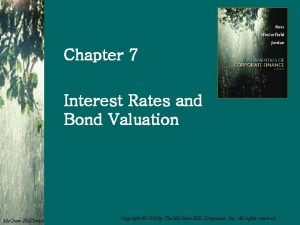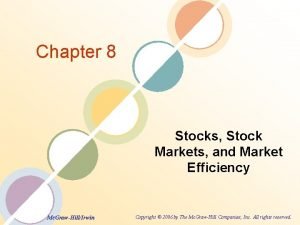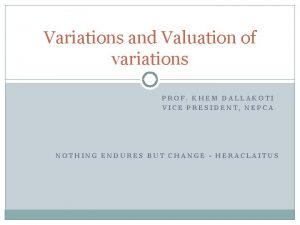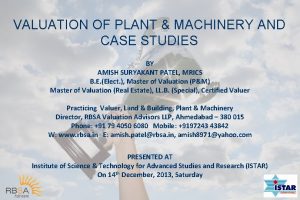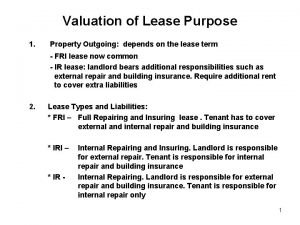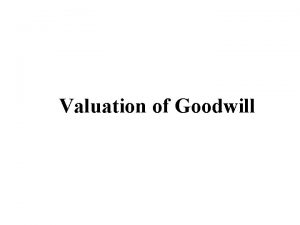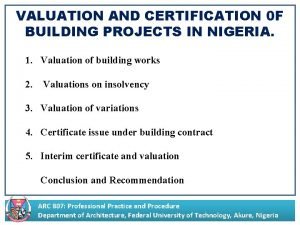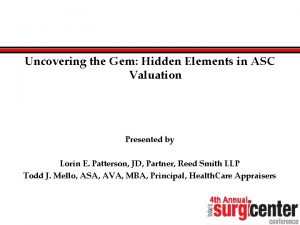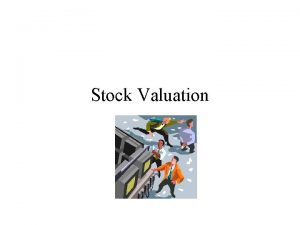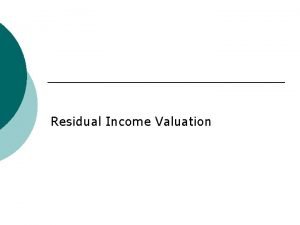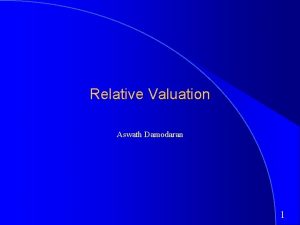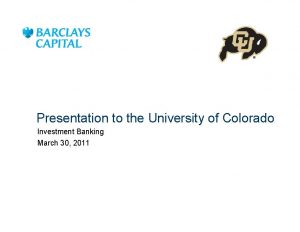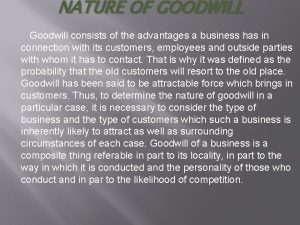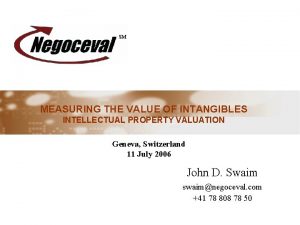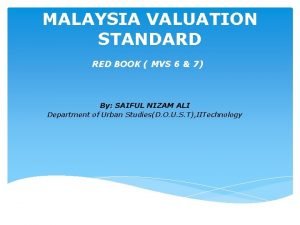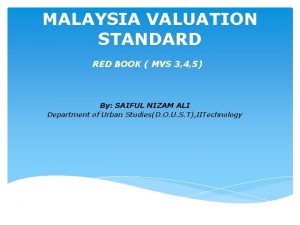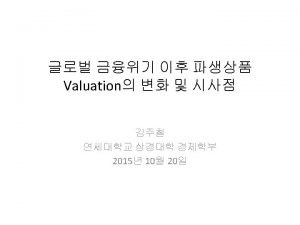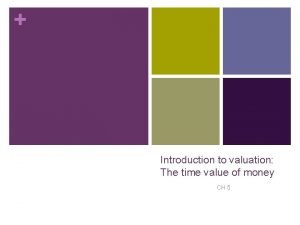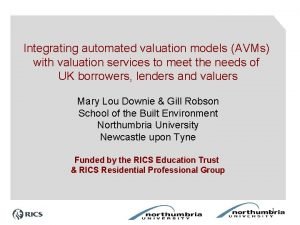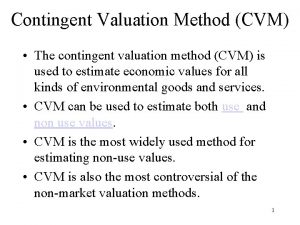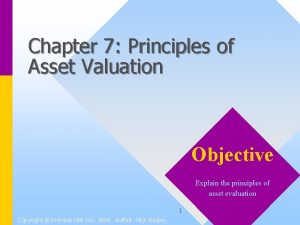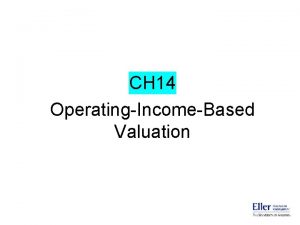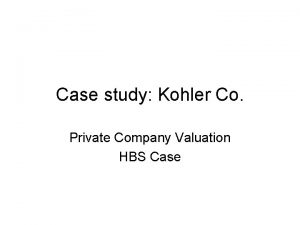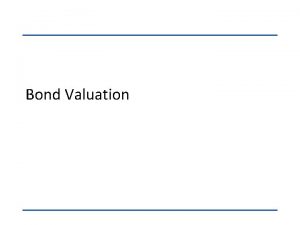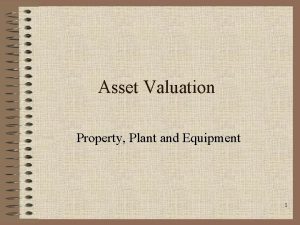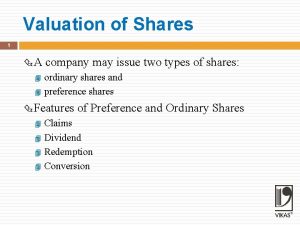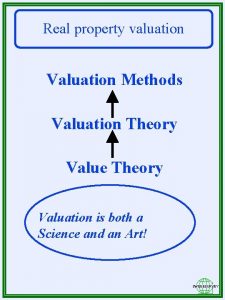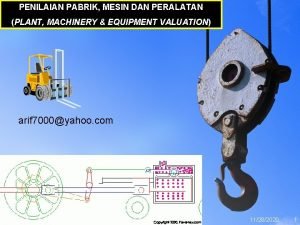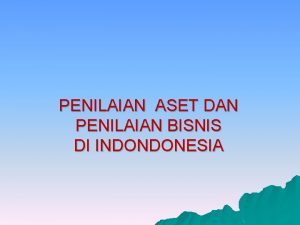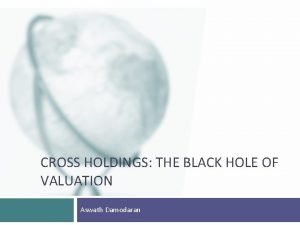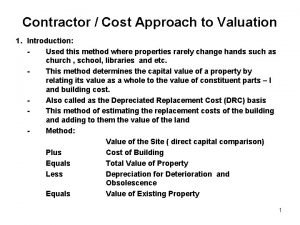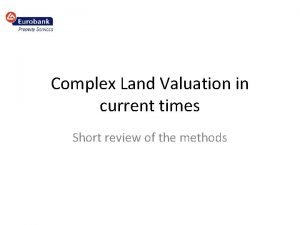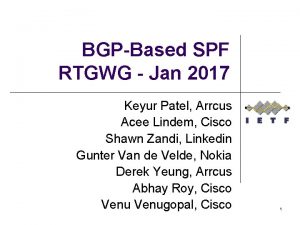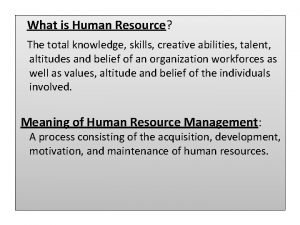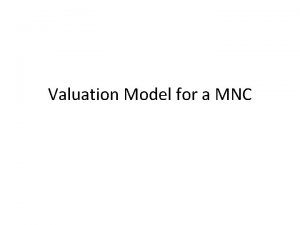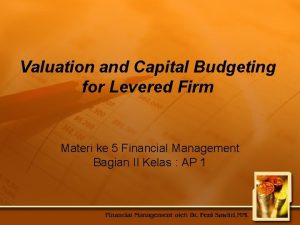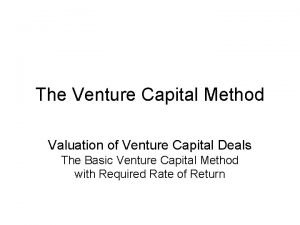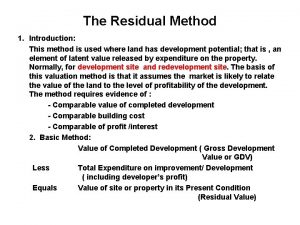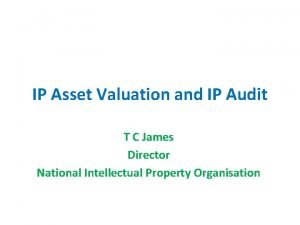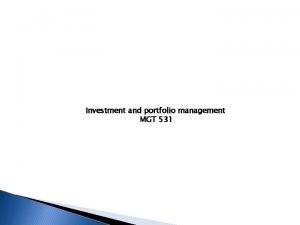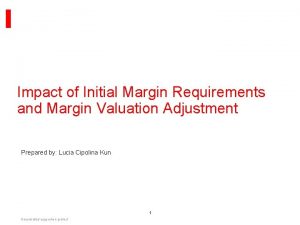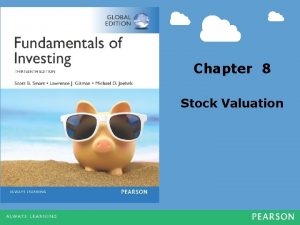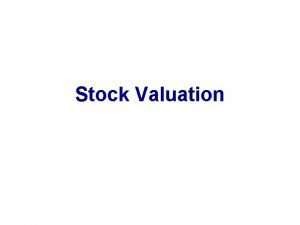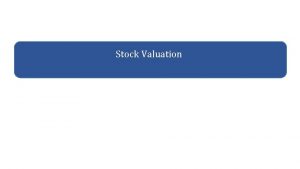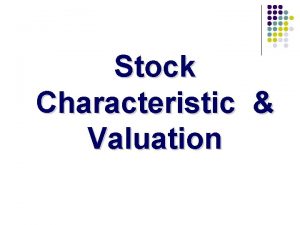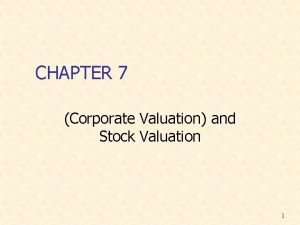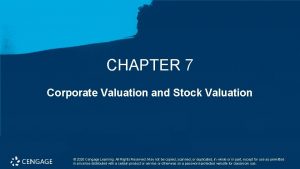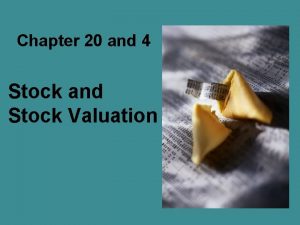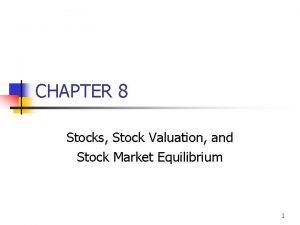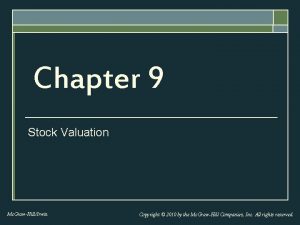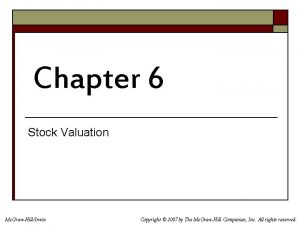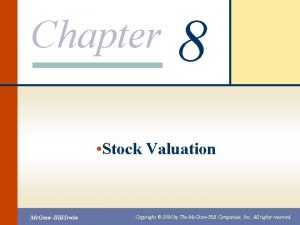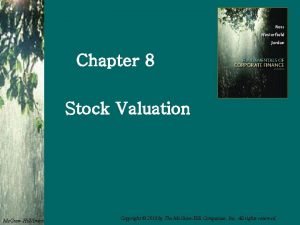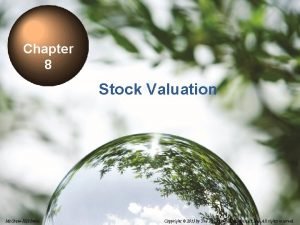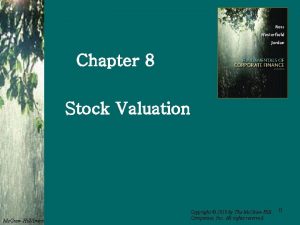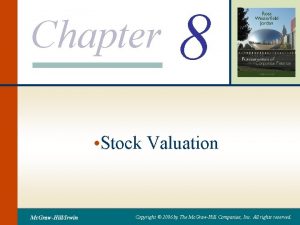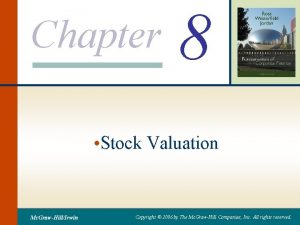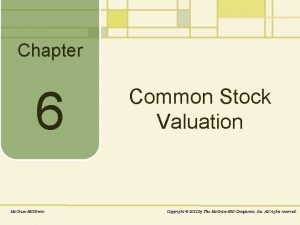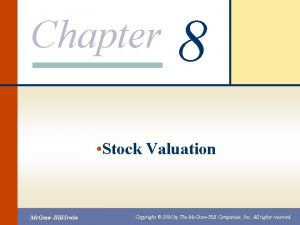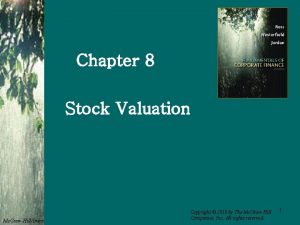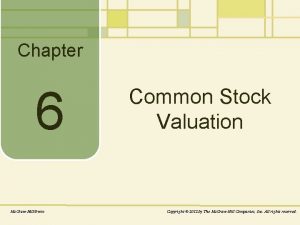Chapter 8 Stock Valuation 8 1 Mc GrawHillIrwin





















































































- Slides: 85

Chapter 8 Stock Valuation 8 -1 Mc. Graw-Hill/Irwin Copyright © 2013 by The Mc. Graw-Hill Companies, Inc. All rights reserved.

Chapter Outline • • • 8 -2 Bond and Stock Differences Common Stock Valuation Features of Common Stock Features of Preferred Stock The Stock Markets

Chapter Outline • • • 8 -3 Bond and Stock Differences Common Stock Valuation Features of Common Stock Features of Preferred Stock The Stock Markets

Bonds and Stocks: Similarities • Both provide long-term funding for the organization • Both are future funds that an investor must consider • Both have future periodic payments • Both can be purchased in a marketplace at a price “today” 8 -4

Bonds and Stocks: Differences • From the firm’s perspective: a bond is a long-term debt and stock is equity • From the firm’s perspective: a bond gets paid off at the maturity date; stock continues indefinitely. • We will discuss the mix of bonds (debt) and stock (equity) in a future chapter entitled capital structure 8 -5

Bonds and Stocks: Differences • A bond has coupon payments and a lump-sum payment; stock has dividend payments forever • Coupon payments are fixed; stock dividends change or “grow” over time 8 -6

A visual representation of a bond with a coupon payment (C) and a maturity value (M) 8 -7 1 2 3 4 5 $C 1 $C 2 $C 3 $C 4 $C 5 $M

A visual representation of a share of common stock with dividends (D) forever 8 -8 1 2 3 4 $D 1 $D 2 $D 3 $D 4 5 ∞ $D 5 $D∞

Comparison Valuations 0 1 P 0 C 0 P 0 8 -9 Bond 2 3 C C M Common Stock 1 2 3 D 1 D 2 D 3 D∞

Notice these differences: • The “C’s” are constant and equal • The bond ends (year 5 here) • There is a lump sum at the end 8 -10 1 2 3 4 5 $C 1 $C 2 $C 3 $C 4 $C 5 $M

Notice these differences: • The dividends are different • The stock never ends • There is no lump sum 8 -11 1 2 3 4 5 $D 1 $D 2 $D 3 $D 4 $D 5 ∞ $D∞

Chapter Outline • • • 8 -12 Bond and Stock Differences Common Stock Valuation Features of Common Stock Features of Preferred Stock The Stock Markets

Our Task: To value a share of Common Stock 8 -13

And how will we accomplish our task? 8 -14

8 -15 B A E F E I P V T Bring All Expected Future Earnings Into Present Value Terms

Just remember: BAEFEIPVT 8 -16

Cash Flows for Stockholders If you buy a share of stock, you can receive cash in two ways: 1. The company pays dividends 8 -17 2. You sell your shares, either to another investor in the market or back to the company

One-Period Example Receiving one future dividend and one future selling price of a share of common stock 8 -18

One-Period Example Suppose you are thinking of purchasing the stock of Moore Oil, Inc. You expect it to pay a $2 dividend in one year, and you believe that you can sell the stock for $14 at that time. If you require a return of 20% on investments of this risk, what is the maximum you would be willing to pay? 8 -19

Visually this would look like: R = 20% 1 D 1 = $2 P 1 = $14 8 -20

Compute the Present Value R = 20% $1. 67 $11. 67 PV =$13. 34 8 -21 1 D 1 = $2 P 1 = $14

TI BA II Plus -13. 34 1 year = N 20% = Discount rate $2 = Payment (PMT) $14 = FV 1 st 2 nd 8 -22 PV = ?

1 year = N HP 20% = Discount rate $2 = Payment (PMT) PV = ? $14 = FV -13. 34 8 -23 12 -C

Two Period Example Now, what if you decide to hold the stock for two years? In addition to the dividend in one year, you expect a dividend of $2. 10 in two years and a stock price of $14. 70 at the end of year. Now how much would you be willing to pay? 8 -24

Visually this would look like: R = 20% 1 D 1 = $2 8 -25 2 D 2 = $ 2. 10 P 2 = $14. 70

Compute the Present Value R = 20% $1. 67 $1. 46 $ 10. 21 $ 13. 34 = P 0 8 -26 1 D 1 = $2 2 D 2 = $ 2. 10 P 2 = $14. 70

What is the Observed Pattern? We value a share of stock by bring back all expected future dividends into present value terms 8 -27

Future Dividends So the key is to determine the future dividends when given the growth rate of those dividends, whether the growth is zero, constant, or unusual first and then levels off to a constant growth rate. 8 -28

So how do you compute the future dividends? Three scenarios: 1. A constant dividend (zero growth) 2. The dividends change by a constant growth rate 3. We have some unusual growth periods and then level off to a constant growth rate 8 -29

So how do you compute the future dividends? Three scenarios: 1. A constant dividend (zero growth) 2. The dividends change by a constant growth rate 3. We have some unusual growth periods and then level off to a constant growth rate 8 -30

1. Constant Dividend – Zero Growth • The firm will pay a constant dividend forever • This is like preferred stock • The price is computed using the perpetuity formula: P 0 = D / R 8 -31

So how do you compute the future dividends? Three scenarios: 1. A constant dividend (zero growth) 2. The dividends change by a constant growth rate 3. We have some unusual growth periods and then level off to a constant growth rate 8 -32

2. Constant Growth Rate of Dividends are expected to grow at a constant percent period. P 0 = D 1 /(1+R) + D 2 /(1+R)2 + D 3 /(1+R)3 + … P 0 = D 0(1+g)/(1+R) + D 0(1+g)2/(1+R)2 + D 0(1+g)3/(1+R)3 + … 8 -33

2. Constant Growth Rate of Dividends With a little algebra this reduces to: 8 -34

2. Constant Growth Rate of Dividends Student caution: 8 -35 A. What happens if g > R? B. What happens if g = R?

Dividend Growth Model (DGM) Assumptions To use the Dividend Growth Model (aka the Gordon Model), you must meet all three requirements: 1. The growth of all future dividends must be constant, 2. The growth rate must be smaller than the discount rate ( g < R), and 3. The growth rate must not be equal to the discount rate (g ≠ R) 8 -36

DGM – Example 1 Suppose Big D, Inc. , just paid a dividend (D 0) of $0. 50 per share. It is expected to increase its dividend by 2% per year. If the market requires a return of 15% on assets of this risk, how much should the stock be selling for? 8 -37

DGM – Example 1 Solution P 0 = 8 -38 . 50 ( 1 +. 02). 15 -. 02. 51. 13 = $3. 92

DGM – Example 2 Suppose Moore Oil Inc. , is expected to pay a $2 dividend in one year. If the dividend is expected to grow at 5% per year and the required return is 20%, what is the price? 8 -39

DGM – Example 2 Solution P 0 = 8 -40 2. 00. 20 -. 05 2. 00. 15 = $13. 34

So how do you compute the future dividends? Three scenarios: 1. A constant dividend (zero growth) 2. The dividends change by a constant growth rate 3. We have some unusual growth periods and then level off to a constant growth rate 8 -41

3. Unusual Growth; Then Constant Growth Just draw the time line with the unusual growth rates identified and determine if/when you can use the Dividend Growth Model. Deal with the unusual growth dividends separately. 8 -42

Non-constant Growth Problem Statement Suppose a firm is expected to increase dividends by 20% in one year and by 15% for two years. After that, dividends will increase at a rate of 5% per year indefinitely. If the last dividend was $1 and the required return is 20%, what is the price of the stock? 8 -43

Non-constant Growth Problem Statement Draw the time line and compute each dividend using the corresponding growth rate: 1 2 3 D 1 D 2 D 3 = g = 20% g = 15% g = 5% 0 1. 0 D 0 $ 8 -44 4 ∞

Non-constant Growth Problem Statement Draw the time line and compute each dividend using the corresponding growth rate: 1 2 3 = g = 20% g = 15% g = 5% 0 1. 0 D 0 $ D 1=1. 20 D 2 4 ∞ D 3 D 1 = ($1. 00) (1 + 20%) = $1. 00 x 1. 20 = $1. 20 8 -45

Non-constant Growth Problem Statement Draw the time line and compute each dividend using the corresponding growth rate: 1 2 3 D 1 D 2=1. 38 D 3 = g = 20% g = 15% g = 5% 0 1. 0 D 0 $ 4 ∞ D 2 = ($1. 20) (1 + 15%) = $1. 20 x 1. 15 = $1. 38 8 -46

Non-constant Growth Problem Statement Draw the time line and compute each dividend using the corresponding growth rate: 1 2 3 D 1 D 2 D 3 =1. 59 = g = 20% g = 15% g = 5% 0 1. 0 4 D 0 $ ∞ D 3 = ($1. 38) (1 + 15%) = $1. 38 x 1. 15 = $1. 59 8 -47

Non-constant Growth Problem Statement Now we can use the DGM starting with the period of the constant growth rate at our time frame of year 3: R = 20% 1 2 3 D 1 D 2 D 3 = g = 20% g = 15% g = 5% 0 1. 0 D 0 $ P 3 = D 4/R – g 8 -48 4 ∞ P 3 = D 3 (1 + g) / R - g

Non-constant Growth Problem Statement Now we can use the DGM starting with the period of the constant growth rate at our time frame of year 3: R = 20% 1 2 3 D 1 D 2 D 3 = g = 20% g = 15% g = 5% 0 1. 0 4 D 0 $ ∞ P 3 = D 3 (1 + g) / R - g 8 -49 P 3 = 1. 59 (1. 05)/. 20 -. 05 = $11. 13

Non-constant Growth Problem Statement We now have all of the dividends accounted for and we can compute the present value for a share of common stock: R = 20% 1 2 3 = g = 20% g = 15% g = 5% 0 1. 0 4 D 0 $ 8 -50 D 1 D 2 D 3 1. 20 1. 38 1. 59 P 3 = 11. 13 ∞

Non-constant Growth Problem Statement BAEFEIPVT! 1 R = 20% 2 3 = g = 20% g = 15% g = 5% 0 1. 0 4 D 0 $ $9. 32 8 -51 D 2 D 3 1. 20 1. 38 1. 59 P 3 = 11. 13 ∞

Stock Price Sensitivity to Dividend Growth, g D 1 = $2; R = 20% 250 Stock Price 200 150 100 50 0 0 8 -52 0. 05 0. 1 Growth Rate 0. 15 0. 2

Stock Price Sensitivity to Required Return, R D 1 = $2; g = 5% 250 Stock Price 200 150 100 50 0 0 0. 05 0. 15 Growth Rate 8 -53 0. 25 0. 3

Using the DGM to Find R Start with the DGM and then algebraically rearrange the equation to solve for R: 8 -54

Finding the Required Return - Example Suppose a firm’s stock is selling for $10. 50. It just paid a $1 dividend, and dividends are expected to grow at 5% per year. What is the required return? R = [1(1. 05)/10. 50] +. 05 = 15% What is the dividend yield? 1(1. 05) / 10. 50 = 10% What is the capital gains yield? g =5% 8 -55

Stock Valuation Alternative But my company doesn’t pay dividends! How can I value the stock? 8 -56

Valuation Using Multiples We can use the PE ratio and/or the price-sales ratio: Pt = Benchmark PE ratio X EPSt Pt = Benchmark price-sales ratio X Sales per sharet 8 -57

Stock Valuation Summary 8 -58

Chapter Outline • • • 8 -59 Bond and Stock Differences Common Stock Valuation Features of Common Stock Features of Preferred Stock The Stock Markets

Features of Common Stock • Voting Rights • Proxy voting • Classes of stock 8 -60

Features of Common Stock Other Rights • Share proportionally in declared dividends • Share proportionally in remaining assets during liquidation • Preemptive right – first shot at new stock issue to maintain proportional ownership if desired 8 -61

Dividend Characteristics • Dividends are not a liability of the firm until a dividend has been declared by the Board • Consequently, a firm cannot go bankrupt for not declaring dividends 8 -62

Dividend Characteristics Dividends and Taxes • Dividend payments are not considered a business expense; therefore, they are not tax deductible • The taxation of dividends received by individuals depends on the holding period • Dividends received by corporations have a minimum 70% exclusion from taxable income 8 -63

Chapter Outline • • • 8 -64 Bond and Stock Differences Common Stock Valuation Features of Common Stock Features of Preferred Stock The Stock Markets

Features of Preferred Stock Dividends • Stated dividend that must be paid before dividends can be paid to common stockholders • Dividends are not a liability of the firm, and preferred dividends can be deferred indefinitely 8 -65

Features of Preferred Stock Dividends • Most preferred dividends are cumulative – any missed preferred dividends have to be paid before common dividends can be paid 8 -66

Features of Preferred Stock • Preferred stock generally does not carry voting rights 8 -67

Chapter Outline • • • 8 -68 Bond and Stock Differences Common Stock Valuation Features of Common Stock Features of Preferred Stock The Stock Markets

Stock Market, Dealers vs. Brokers Dealer: trades with inventory for bid and ask prices Broker: matches buyers and sellers for a fee 8 -69

Stock Market • New York Stock Exchange (NYSE) • Largest stock market in the world • License holders (1, 366) • Commission brokers • Specialists • Floor brokers • Floor traders • Operations • Floor activity 8 -70

NASDAQ • Not a physical exchange – it is a computerbased quotation system • Multiple market makers • Electronic Communications Networks 8 -71

NASDAQ • Three levels of information: • Level 1 – median quotes, registered representatives • Level 2 – view quotes, brokers & dealers • Level 3 – view and update quotes, dealers only • A large portion of technology stocks are bought and sold each day on NASDAQ 8 -72

Work the Web • Electronic Communications Networks provide trading in NASDAQ securities • Click on the web surfer and visit Instinet 8 -73

Reading Stock Quotes 8 -74

Work the Web • Click on the web surfer to go to Bloomberg for current stock quotes. 8 -75

Ethics Issues The status of pension funding (i. e. , over- vs. under-funded) depends heavily on the choice of a discount rate. When actuaries are choosing the appropriate rate, should they give greater priority to future pension recipients, management, or shareholders? How has the increasing availability and use of the internet impacted the ability of stock traders to act unethically? 8 -76

Quick Quiz What is the value of a stock that is expected to pay a constant dividend of $2 per year if the required return is 15%? What if the company starts increasing dividends by 3% per year, beginning with the next dividend? The required return stays at 15%. 8 -77

Comprehensive Problem XYZ stock currently sells for $50 per share. The next expected annual dividend is $2, and the growth rate is 6%. What is the expected rate of return on this stock? If the required rate of return on this stock were 12%, what would the stock price be, and what would the dividend yield be? 8 -78

Terminology Bonds versus Common Stock Cash Dividends Capital Gain Yield & Dividend Yield Dividend Growth Model (DGM) Preferred Stock Market – NYSE Electronic Exchange – NASDAQ Stock Quotes 8 -79

Formulas Value of a Perpetuity: P 0 = D R Value of a Share of Common Stock using the DGM: 8 -80

Formulas Value of a Share of Common Stock using Multiples Pt = Benchmark PE ratio X EPSt Pt = Benchmark price-sales ratio X Sales per sharet 8 -81

Key Concepts and Skills • Compute the future dividend stream based on dividend growth • Use the Dividend Growth Model (DGM) to determine the price of stock • Explain how stock markets work • Describe the workings of a stock exchange 8 -82

What are the most important topics of this chapter? 1. A stock’s value is the present value of all expected future earnings. 2. Computing the future dividends of a stock is the key to understanding its value 3. Issuing stock provides the firm longterm funding 8 -83

What are the most important topics of this chapter? 4. The Dividend Growth Model (DGM) provides us help with infinite dividend streams 5. Stocks are bought and sold each business day with reporting via stock quotes 8 -84

Questions? 8 -85
 Valuation of fixed income securities
Valuation of fixed income securities Company analysis stock valuation
Company analysis stock valuation Avco stock valuation
Avco stock valuation Company analysis stock valuation
Company analysis stock valuation Characteristics of stock valuation
Characteristics of stock valuation Inventory valuation grade 12
Inventory valuation grade 12 Equity markets and stock valuation
Equity markets and stock valuation Dividend growth model formula
Dividend growth model formula Preferred stock valuation
Preferred stock valuation Features of preferred stock
Features of preferred stock White stock dan brown stock
White stock dan brown stock Characteristics of common stock
Characteristics of common stock Stock initial - stock final
Stock initial - stock final Chapter 7 interest rates and bond valuation
Chapter 7 interest rates and bond valuation Chapter 9 inventories additional valuation issues
Chapter 9 inventories additional valuation issues Chapter 6 discounted cash flow valuation
Chapter 6 discounted cash flow valuation How to find the price of a bond
How to find the price of a bond Chapter 6 interest rates and bond valuation
Chapter 6 interest rates and bond valuation Lower-of-cost-or-market
Lower-of-cost-or-market Chapter 7 interest rates and bond valuation
Chapter 7 interest rates and bond valuation Chapter 6 interest rates and bond valuation
Chapter 6 interest rates and bond valuation Chapter 8 the stock market
Chapter 8 the stock market Valuation of variations
Valuation of variations Valuation of plant and machinery
Valuation of plant and machinery What is outgoing in valuation
What is outgoing in valuation Capital employed formula from liabilities side
Capital employed formula from liabilities side Valuation model for an mnc
Valuation model for an mnc Valuation certificate for building
Valuation certificate for building Skillshare valuation
Skillshare valuation Asc valuation
Asc valuation Generalized dividend valuation model
Generalized dividend valuation model Contingent valuation method
Contingent valuation method What is residual income
What is residual income Relative valuation
Relative valuation Football field valuation
Football field valuation Valuation approach
Valuation approach Arbitrary method of goodwill
Arbitrary method of goodwill Valuing intangible assets
Valuing intangible assets Pe multiple valuation
Pe multiple valuation Malaysian valuation standard 2021
Malaysian valuation standard 2021 Red mvs definition
Red mvs definition General surveying services
General surveying services Credit value adjustments
Credit value adjustments Introduction to valuation the time value of money
Introduction to valuation the time value of money Contractors method of valuation
Contractors method of valuation Sum-of-the-parts valuation
Sum-of-the-parts valuation Automated valuation model uk
Automated valuation model uk Fuze valuation
Fuze valuation Gv roll 2018
Gv roll 2018 Gas station valuation
Gas station valuation Contingent valuation method
Contingent valuation method Myweb valuation
Myweb valuation Contingent valuation method
Contingent valuation method 7 principles of valuation
7 principles of valuation Calculate price of bond
Calculate price of bond Ropi model
Ropi model Kohler case solution
Kohler case solution Semi annual formula
Semi annual formula Aswath damodaran
Aswath damodaran Private company valuation damodaran
Private company valuation damodaran Property plant and equipment
Property plant and equipment Need for valuation of goodwill
Need for valuation of goodwill Dual method of share valuation
Dual method of share valuation A company may issue …………
A company may issue ………… Valuation of fixed income securities
Valuation of fixed income securities Valuation theory
Valuation theory Engine scoring
Engine scoring Asset based valuation
Asset based valuation Jetblue airways ipo valuation
Jetblue airways ipo valuation Cadre valuation
Cadre valuation Cross holding valuation
Cross holding valuation Contractors method of valuation
Contractors method of valuation Residual method of valuation pros and cons
Residual method of valuation pros and cons Cadre valuation
Cadre valuation Arrcus valuation
Arrcus valuation Unpurchased goodwill method
Unpurchased goodwill method Valuation model for an mnc example
Valuation model for an mnc example Valuation and capital budgeting for the levered firm
Valuation and capital budgeting for the levered firm Venture capital method
Venture capital method Residual method example
Residual method example Spirit of performance koenigsegg
Spirit of performance koenigsegg Residual income model valuation
Residual income model valuation Ip valuation audit
Ip valuation audit Equity analysis and valuation
Equity analysis and valuation Lucia cipolina kun
Lucia cipolina kun Gas station valuation
Gas station valuation

